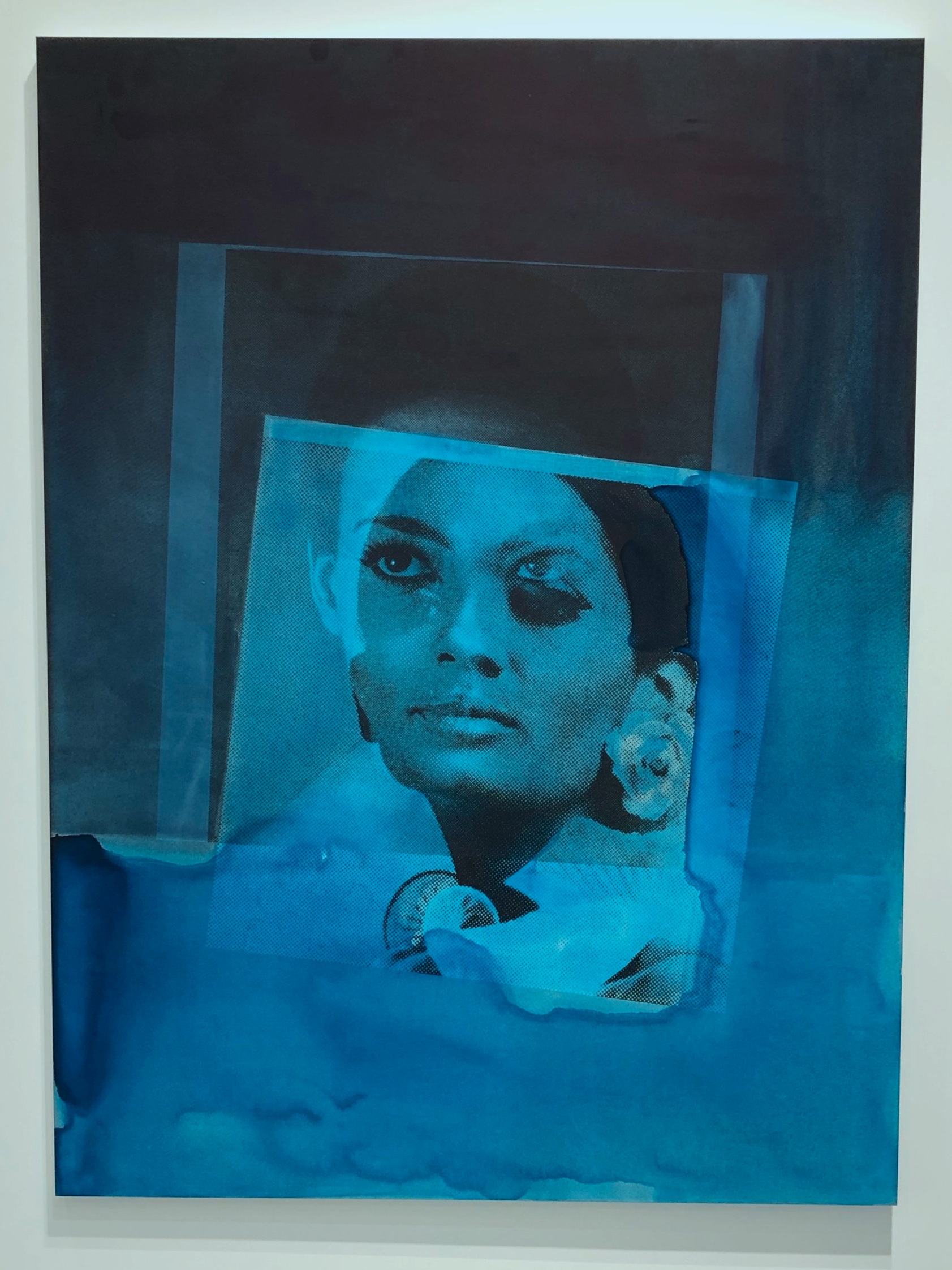black-white-blue-black
Lorna Simpson at Hauser & Wirth
© Lorna Simpson. Courtesy the artist and Hauser & Wirth. Photo: James Wang
Darkening at Hauser & Wirth is the first the United States has seen of Lorna Simpson’s new body of painting, a departure for an artist known primarily for photo collages of black women taken from the pages of Ebony and Jet magazines.
The show is made up of twelve paintings (and a single sculpture), which fall into two seemingly unrelated categories: icebergs (or mountains?–– it’s hard to tell) and women. Almost all are covered in a wash of royal blue.
Though her medium is different, many of Simpson’s themes remain close at hand––as in her Special Character series, in which screen prints of women are superimposed over each other, creating eerie composite portraits overlaid in vibrant colors like yellow and cyan. The nature of layering found images such as these ensures that these faces do not align, making it impossible to meet their gaze. They set the tone for the show, over which a distant stillness pervades.
Darkened. 2018. Ink and screenprint on gessoed wood. 274.3 x 243.8 x 3.2 cm / 108 x 96 x 1 1/4 in. © Lorna Simpson Courtesy the artist and Hauser & Wirth Photo: James Wang
This distance in the face of monumental indifference is emphasized by the numerous (enormous) images of icebergs, which rise mistily behind their blue curtains. Visible beneath the paint are strips of text, made unreadable (and therefore meaningless?) by their limited vantage.
As satellites to her figurative works, the icebergs certainly add chilling depth, but whether they could stand on their own was something I puzzled over as I walked through the gallery. In the end, I concluded that much of their significance would be drained from them if they were moved into a room without their icy compatriots. That the majority of the show is comprised of these paintings is perhaps a missed opportunity, as I would have liked to have seen a few smaller works (or perhaps a few more sculptures?). All in all, they left me, well…cold.
When it comes to understanding the show as a whole, however, it is in the literature that things get interesting. Excerpted in the press release is a poem by Robin Coste Lewis, in which she writes of a visit to the Arctic: “The unanticipated shock: so much believed to be white is actually –/ strikingly –/blue. Endless blueness.”
Special Character #2. 2019. Ink and screenprint on gessoed fiberglass. 170.2 x 127 x 3.5 cm / 67 x 50 x 1 3/8 in.
This conflation of color touches on a rich tradition of the representation of race in art. In a conversation with the increasingly-legendary Thelma Golden, Simpson calls attention to the 2017 Pulitzer Arts Foundation exhibition Blue Black, curated by her friend, the artist Glenn Ligon. A non-chronological ramble, the exhibition explored the relationship between the colors black and blue and their tendency to slip into each other. The relationship is not just formal, of course, and can often be a deeply felt way of communicating something fundamental about blackness.
In a piece on the subject of the show published by The New York Review of Books, Ligon explains that the term blue black (and alternatively, blueblack and blue-black) is “used primarily by African Americans to describe a skin tone found among dark-skinned people on the African continent,” but more than that “blue-black traces its roots back to a mythic point of origin in Africa, whereas “black,” along with “Negro” and “African American,” might be considered just one more stopping point on the way to an as-yet-unknown destination.” Blue black is an origin point, and maybe, for Simpson, an ending. (This show is called Darkening, after all.)
Source Notes. 2019. Ink and screenprint on gessoed fiberglass. 365.8 x 259.1 x 3.5 cm / 144 x 102 x 1 3/8 in. © Lorna Simpson. Courtesy the artist and Hauser & Wirth. Photo: James Wang
Many of these works would have happily hung in Ligon’s show, as in Source Notes, where a woman gazes over her shoulder out and towards us through a shroud of vibrant blue. She has been inundated, but not quite smothered by this celestial veil.
But if black is blue and white is blue, where are we left? In Darkening, blueness might be the condition that we are suffering together, in the same way, perhaps, that blackness and whiteness, too, are conditions we suffer together, as the concept of whiteness brings blackness into existence––and vice versa.
As Simpson describes it, her show has something to do with the feeling of being in America today, the encroachment of a menacing, but as-yet-unidentified threat. White is really blue and blue is really black. Whether we are converging on a point, an as-yet-unknown destination, or endlessly circling, we cannot know. The clouds have rolled in, and we are waiting for the skies to open with the first clap of thunder.
Hauser & Wirth (22nd Street)
Until July 26




